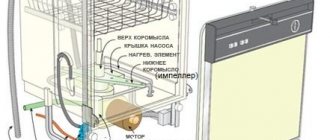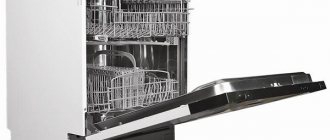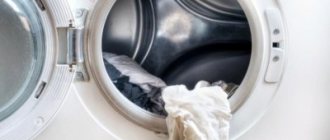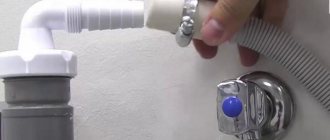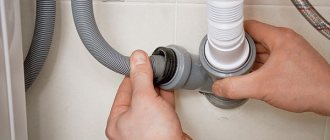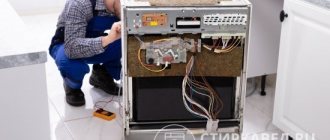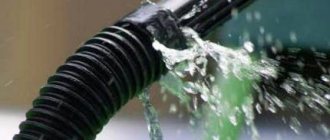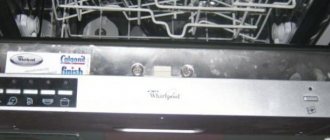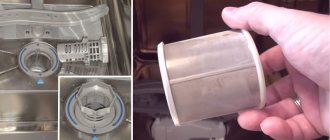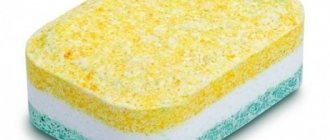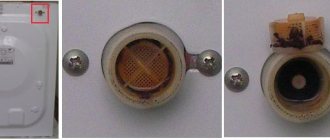E09 is the third most popular error in a Bosch dishwasher (after E15 and E24) that our customers encounter. It lights up on the dishwasher display:
- immediately after starting (it doesn’t come to the point of drawing water);
- or at the beginning of the wash cycle, approximately 10 minutes after start.
If you look inside a Bosch dishwasher that has filled with water and stopped with code E09, you will find that the water is cold and has not warmed up. In this case, in the pre-rinse mode, when heating is not required, the dishwasher can function normally: no errors occur.
Why does error e09 appear?
In 10% of cases, error E09 in a dishwasher may indicate:
- about software failure;
- about faulty electrical wiring, poor contact in the socket;
- about the discrepancy between the cross-section of the electrical cable and the power consumption of the equipment;
- about a temperature sensor that has become unusable;
- about errors in the operation of the main module.
In 90% of cases, this is a breakdown of the heating element, as a result of which it is necessary to repair or replace this heating element.
The following provoking factors lead to breakdown of the heating element:
- period of operation of the machine: the older it is, the greater the likelihood of a malfunction;
- scale on the heater, as a result of which it takes longer to heat the water, constantly overheats and, ultimately, burns out;
- filter clogged: as a result, poor water circulation and overheating of the heating element, as a result, it fails;
- worn-out pipes, hoses, seals lead to depressurization and water entering the contacts - a short circuit, the heating element burns out.
Malfunction with code E27 - how to fix it, you can find out at the link.
DIY electric heater replacement
The heating element, with the recommended skills, can be replaced independently. For repairs you will need the following tools:
- new working part;
- multimeter;
- crosshead screwdriver.
As mentioned above, the water heater in dishwashers is connected to a circulation unit. To remove it from the machine, you need to completely disassemble the device and replace the damaged part with a new one.
The Bosch machine is connected not only to the water supply, but also to the sewerage system and electricity. First, the household appliance is disconnected from all communications.
At the next stage, the front part of the unit is removed. To do this, unscrew the plastic clips. They are located at the edges of the machine body. Disconnect the metal panel located under the door of the device.
Afterwards the thermal insulation is removed. Disconnect the screws that support the tray. Open the dishwasher door and remove the basket intended for dishes. The sprinkler located below is removed. Unscrew the drain filter. Remove the metal mesh located at the bottom of the dishwasher.
The screws located on the side of the hopper and fixing the recirculation unit are removed. Place a large cloth behind the dishwasher that absorbs water well. The household appliance is placed on the back. The filling pipe is disconnected from the recirculation unit. Remove the pallet. The drain pump is turned clockwise and disconnected. The circulation block is removed from the mounts.
The drain hose from the machine is removed and the unit is removed to the outside, after removing the chips with wires. The clamp connecting the heating element to the circulation pump is removed. They take out a new part and install it in place of the damaged one. At the same time, screw in all the chips. The dishwasher parts are installed in place. If you doubt the serviceability of the heating element, use a multimeter to determine the contact resistance.
How to fix a problem in ten percent of cases
If the error appears for the first time, perhaps not everything is so bad and it is enough to reload the program. To do this, you need to turn off the power to the machine by unplugging the plug from the socket, wait 10 minutes and turn it on. If the error no longer appears, the problem has been resolved.
It is necessary to check the wiring, replace the socket, and eliminate the defect in the electrical network immediately. Delay can lead to fire, electric shock, and serious equipment breakdown with costly repairs.
If it is discovered that the water heating does not stop, or the dishwasher does not heat the water at all, you should pay attention to the temperature sensor. Overheating of the heating element will lead to its failure and may even cause a fire. Therefore, the dishwasher must be turned off immediately. The temperature sensor needs to be repaired or replaced.
Malfunctions of the control unit elements can lead to incorrect operation of the temperature control circuit of the water heater. Sensor failure occurs due to voltage fluctuations in the electrical network. This malfunction can be eliminated by replacing the electronic components on the control unit.
Problems with draining and filling water
During draining and filling of water, a large number of malfunctions occur. Possible errors of Bosch dishwashers during this process are reflected on the screen with the following block of codes:
1. Code E3 (F3) - lights up on the screen in case of failures with water filling. The executive program includes the time during which the machine is filled with water. If it is not filled within the programmed time, the machine stops.
To identify and eliminate the error, check:
- presence of water in the water supply;
- inlet filter condition;
- serviceability of the intake valve;
- the serviceability of the sensor that determines the water level.
If the above checks do not produce results, then the functionality of the pump is checked.
2. Code E5 (F5) - appears on the display when the tank is overfilled with water. First of all, this is due to the operation of the sensor that determines the water level.
To identify and eliminate errors, check:
- condition of the sensor tube for the absence of dirt;
- serviceability of contacts and supply wires of the sensor;
- the fill valve is in good working order to ensure there is no blockage due to which the water is not completely shut off.
3. Code E8 (F8) - appears on the display when the water level in the pan is low. If there is a lack of water, the circulation pump stops.
To eliminate the error, use the E3 (F3) code recommendations described earlier.
4. Code E16 (F16) - lights up on the screen when the tank is filled with water unauthorized. Most often this is due to a malfunction of the intake valve. For example, there is a blockage with debris, so it does not completely block the flow of water.
To identify and eliminate the error, check:
- intake valve condition;
- serviceability of the sensor that determines the water level;
- no increased amount of cleaning foam.
5. Code E17 (F17) - appears on the display if there are problems with water supply. First of all, this is due to increased water pressure in the water supply. In this case, the normal operation of the valve that admits water is disrupted.
How to fix the error:
- if the increase in pressure is due to water hammer, then the dishwasher simply reboots;
- The water pressure level at the machine inlet is checked. The pressure is reduced by the valve on the riser;
- The functionality of the flow sensor is checked.
4. Code E21 (F21) - lights up on the screen when the drain pump stops. In this case, control commands are sent to it, but there is no drain.
How to fix the error:
- the condition of the impeller is checked for jamming;
- the condition of the bearings and pump rotor is checked;
- If necessary, replace the worn pump.
Some tips for further use.
To avoid encountering error e09 in the future, you should follow these simple rules when using a dishwasher:
- periodically check the condition of gaskets, seals, hoses and pipes, timely replace worn ones to avoid leaks;
- Regularly clean and rinse the filter mesh to remove debris, mucus and food debris, avoid clogging and fluid stagnation;
- use products to soften water and prevent scale formation;
- in case of frequent power surges, install a stabilizer to prevent failure of the control module;
- use the services of a qualified specialist to properly connect the installed dishwasher to the household electrical network.
These tips will help extend the life of your home appliance and minimize the risk of breakdowns with subsequent expensive repairs to dishwashers.
Design and principle of operation of Bosch boilers
The most popular models among the Bosch boiler line are double-circuit. They are faced with two tasks: the first is to heat the room to a given temperature, the second is to provide hot water for domestic needs.
Bosch devices, namely the Bosch Gas 4000 W and Junkers Bosch models, are equipped with two independent heat exchangers, which allows them to perfectly perform two tasks: heating water and providing heat in the room.
In each of the models, it is possible to choose the device power that suits you from 12 to 35 kW; the selection takes into account the area of the room. As for heating liquids for household needs, the productivity is about 8-13 liters per minute.
Advantages of a wall-mounted double-circuit boiler:
- Economical gas consumption.
- Easy to install as it is quite small in size.
- Thanks to the hydraulic system and high-quality seals, it operates almost silently, the noise level does not exceed 35 dB.
- Unpretentious in maintenance, easy to operate.
- There is no need for a separate room (boiler room).
The boiler can be mounted in the kitchen wall
. Disadvantages:
- The first 20-40 seconds after you turn on the hot water tap, cold water flows.
Let's take a closer look at how the device works, using the example of the Bosch Gas 4000 W ZWA 24 model. When the boiler is operating in heating mode, heat is transferred using a gas burner to the primary heat exchanger, which is a structure made of copper tubes and plates.
To prevent them from deteriorating from exposure to high temperatures and water, their surface is covered with a protective layer. Its main task is to transfer the heat generated when the flame burns to the heating system. The movement of water in the system is ensured by a pump.
The design also includes a three-way valve, its task is to prevent water from entering the secondary heat exchanger. A secondary heat exchanger is necessary to heat water for domestic needs. The heated liquid for the heating circuit leaves the device through the heating supply line, and the cooled liquid enters through the heating return line.
When the boiler is set to heat water for consumption, the 3-way valve closes the heating circuit. The heated liquid flows from the primary heat exchanger to the secondary one, and then flows out of the device.
Bosch boiler three-way valve
The advantage when using different heat exchangers is obvious. For heating, plain water is often used, but it usually contains impurities. When it is heated, impurities begin to form deposits, which negatively affect the heat exchanger, reduce its throughput, prevent the water from heating, and shorten its service life.
And when the liquid that flows through the primary heat exchanger, it is in a closed circuit, does not change its chemical properties, and minimizes negative consequences.
The fluid that flows through the secondary heat exchanger will develop deposits over time, and over time the heat exchanger will need to be replaced or cleaned. If a malfunction occurs in the winter, your boiler will be able to operate uninterruptedly in heating mode using the primary radiator.
What failure is to blame?
Many modern Bosch dishwashers have an instantaneous water heater installed inside them. The machine draws cold water and then circulates it in a small circle through the heating element until it heats up to the desired temperature. But the question arises: how does the machine’s electronic brain know how much water to fill? An automatic washing machine has a pressure switch, which is connected to the control module. The Bosch dishwasher has a similar system, only instead of a pressure switch there is a water flow sensor, and if it breaks, the self-diagnosis system displays error E14.
This happens in about 65% of cases, so technicians check this sensor first. Secondly, the tightness of the entire system is checked. If there is a small water leak and error E14 flashes on the display, it means a crack has formed somewhere. In more rare cases, this error is caused by the intake valve or control module.
What will it take to fix it?
There is no need to prepare any components or tools in advance. At least until you determine exactly what caused the E14 error. In this paragraph, we will provide a list of what you may need so that you are mentally prepared for the costs that you will have to incur and roughly estimate which stores you will go to to take everything you need. The final list will depend on the nature of the breakdown, the dishwasher model and the method of troubleshooting you choose.
- Screwdrivers: flat, Phillips, hex.
- Pliers.
- New original water flow sensor.
- New original intake valve.
- Multimeter.
- Sealant and tape.
3 reasons why the heating element of a dishwasher burns out
Over time, any piece of equipment wears out and fails, but for a dishwasher heater there are three factors that accelerate its breakdown:
Error E09 almost always indicates a malfunction and requires professional repair. Don’t experiment with a dishwasher like a guinea pig; it’s better to call RemBytTech:
The technician will arrive at your home no later than 24 hours after the call, find out the cause of the error and repair your Bosch dishwasher. Repair work and new spare parts are guaranteed for up to 2 years ; the terms will be indicated on an official receipt stamped and signed by a specialist.
